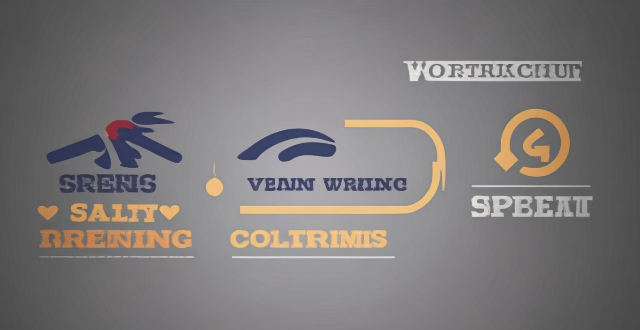
Is high-intensity interval training (HIIT) more effective for mental health than steady-state cardio ?
This article explores whether high-intensity interval training (HIIT) is more effective for mental health than steady-state cardio. HIIT involves short bursts of intense activity followed by periods of rest or low-intensity activity, while steady-state cardio involves maintaining a consistent level of activity for an extended period. Both types of exercise offer benefits for mental health, such as improved mood, reduced anxiety and stress, increased self-efficacy, relaxation, and social opportunities. However, they may appeal to different individuals based on their preferences and goals. Incorporating both types of exercise into a regular routine can provide the most comprehensive benefits for mental health.

Is it better to do cardio or strength training for weight loss ?
When it comes to weight loss, both cardio and strength training have their benefits. Cardio exercises like running, cycling, and swimming can burn a significant number of calories in a short amount of time and improve cardiovascular health. Strength training helps build lean muscle mass, which raises your resting metabolic rate and burns more calories even at rest. While both types of exercise have their advantages, combining them into a well-rounded fitness routine is often the most effective approach for weight loss. A balanced routine that includes both cardio and strength training will improve various aspects of your fitness, including cardiovascular health, muscular strength, and flexibility.

Can you suggest any celebrity-inspired health and wellness programs ?
Celebrity-Inspired Health and Wellness Programs: 1. Jillian Michaels' Fitness Program: Focuses on high-intensity interval training (HIIT) and circuit training, emphasizing a healthy diet and mental well-being. 2. Kayla Itsines' BBG Program: Consists of 28-minute workouts with resistance training, cardio exercises, and recovery periods for home workouts. 3. Joe Wicks' 90-Day Plan: Combines HIIT workouts, strength training, and nutrition guidance for weight loss and muscle gain. 4. Tracy Anderson's Metamorphosis Program: Includes four types of workouts - Cardio, Dance Cardio, Strength, and Flexibility - aiming for a lean, toned body in 90 days. 5. Yoga with Adriene: Offers online yoga classes suitable for all levels, focusing on physical postures, breathing techniques, and meditation for flexibility, strength, and mental well-being.

What are some effective cardio exercises that can be done at the gym ?
Effective Cardio Exercises at the Gym Cardio exercises are an essential part of any fitness routine. They help improve cardiovascular health, burn calories, and increase endurance. Here are some effective cardio exercises that can be done at the gym: 1\. Treadmill Workouts 2\. Elliptical Machines 3\. Stationary Bikes 4\. Rowing Machines 5\. Step Mills 6\. VersaClimber/Vertical Climber 7\. Group Fitness Classes 8\. Other Machines

How does high-intensity interval training (HIIT) differ from steady-state cardio in terms of physiological adaptations ?
High-intensity interval training (HIIT) and steady-state cardio are two popular forms of aerobic exercise that differ in terms of physiological adaptations due to their unique intensity and duration characteristics. HIIT relies on both aerobic and anaerobic energy systems, while steady-state cardio primarily utilizes the aerobic energy system. HIIT promotes muscle hypertrophy and strength gains, while steady-state cardio has minimal impact on muscle hypertrophy and strength gains. HIIT leads to significant improvements in cardiovascular fitness and aerobic capacity, while steady-state cardio results in gradual improvements. HIIT increases insulin sensitivity and fat oxidation, while steady-state cardio has minimal changes in these areas. Overall, HIIT typically leads to more pronounced improvements in cardiovascular fitness, muscle hypertrophy, and metabolic adaptations compared to steady-state cardio.

How long does it take to see improvements in cardiorespiratory fitness from starting an exercise routine ?
When starting an exercise routine to improve cardiorespiratory fitness, noticeable changes can occur within weeks, but significant and lasting improvements typically take several months of consistent training. Factors affecting improvement rates include baseline fitness level, workout frequency and intensity, age, health status, nutrition, recovery, and genetics. To maximize progress, set realistic goals, mix up your routine, monitor your progress, stay consistent, and get adequate rest.

What's wrong with the belief that cardio is the best way to lose weight ?
This critical analysis challenges the prevailing belief that cardio exercises are the most effective way to lose weight. It argues that this belief is misguided due to an overemphasis on calorie burning, neglect of other forms of exercise, potential for overuse injuries, and limited sustainability and enjoyment. The analysis suggests a well-rounded fitness routine that includes strength training, flexibility exercises, and other forms of physical activity to support overall health, prevent injuries, and ensure long-term success in maintaining a healthy weight.

Can you suggest some effective workout splits for different sports ?
Effective workout splits vary based on the specific goals and sports. For strength training, a weekly routine includes different muscle group workouts with rest or cardio days. Endurance training focuses on running, swimming, cycling, with rest or yoga days. Flexibility & mobility require daily morning and evening practices. Sports-specific training is tailored to the demands of the sport, such as basketball drills and game simulations. Incorporate warm-up, cool-down, and adjust intensity to avoid injuries and overtraining.